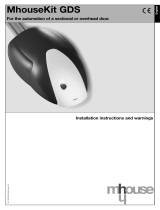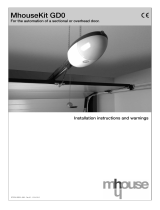12
6.1) Description of functions
Here is a brief description of the functions that can be added by moving the relative Dip-Switch to “ON”.
Switch 1-2: Off-Off = “Manual” movement (man present)
On-Off = “Semiautomatic” movement
Off-On = “Automatic” movement (automatic closing)
On-On = “Automatic + Always Closes” movement
In the “Manual” operating mode, the gate will only move as long as the relative control button is held down.
In the “Semiautomatic” operating mode a command impulse will perform the whole movement until the Working Time limit expires or the
mechanical stop is reached. In the “Automatic” operating mode, an opening manoeuvre is followed by a pause and then an automatic closing
manoeuvre.
The “Always Closes” function comes into play following a power failure; if the gate is open, a closing manoeuvre takes place, automatically
preceded by 5 seconds of pre-flashing.
Switch 3: On = Condominium operating mode (not available in the Manual mode)
In the Condominium operating mode, once an opening manoeuvre has started it cannot be interrupted by other command pulses on “Step-
by-Step” or “Open” until the gate has finished opening.
During a closing manoeuvre, a new command pulse will stop the gate and reverse the direction of movement in order to open the gate.
Switch 4: On = Pre-flashing
A command impulse activates the flashing lamp followed by movement 5 s later (2 s later in the manual mode).
Switch 5: On
= “Close” 5 s after “Photo” <in the “Automatic” mode> or “Close” after “Photo” <in the “Semiautomatic” mode>
This function, if in the “Automatic” mode, allows the gate to be kept open only for the time required for transit; when “Photo” finishes, the
manoeuvre stops. After 5 s a closing manoeuvre will automatically begin. If “Photo” triggers in the “Semiautomatic” mode during a closing
manoeuvre the “Automatic” closing manoeuvre is activated with the adjusted pause time.
Switch 6: On = Safety “Photo” also during the opening manoeuvre
The “Photo” safety device is normally just active during the closing manoeuvre; if Dip-Switch 6 is turned "On" the safety device will also trigger
during the opening manoeuvre.
In the “Semiautomatic” or “Automatic” modes, the opening manoeuvre will start again immediately after the photocell has been disengaged.
Switch 7: On = Gradual departure
Starts the manoeuvre gradually, preventing the automatic system from being jolted.
Switch 8: On = Deceleration
Deceleration reduces speed to 30% of rated speed in order to prevent unnecessary jolts at the end of a manoeuvre.
As well as reducing the speed of the manoeuvre, the deceleration function also reduces motor torque by 70%.
For systems requiring elevated torque, this decrease may cause the motor to stop immediately.
ROBO – THOR version:
Following the opening or closing manoeuvre which takes place at
the end of the Working Time. A deceleration phase lasting as the
Working Time (TL) is carried out .
If the manoeuvre is terminated by the limit switches and the
deceleration phase is not performed, adjust Working Time so that
deceleration begins 30-50 cm before the limit switches cut in.
OTTO version:
Following the closing manoeuvre the deceleration phase lasts 3 s if
triggered by the limit switches and as match as the Working Time
(the deceleration function works better with the limit switches).
During the opening manoeuvre a gradual stopping function is used
instead of the deceleration feature.
If the deceleration function is used on sensitive
installations and if this lasts more than 3 s, install a mains
filter of at least 6A with attenuation of 30dB on the mains















